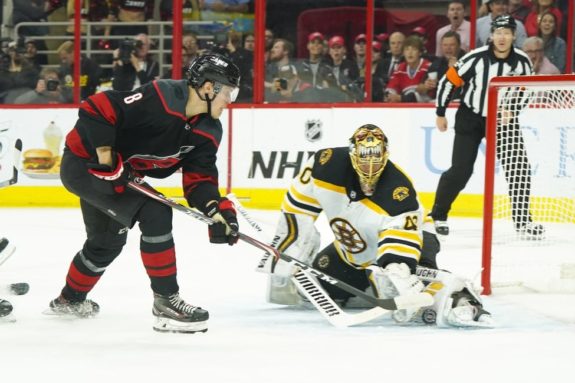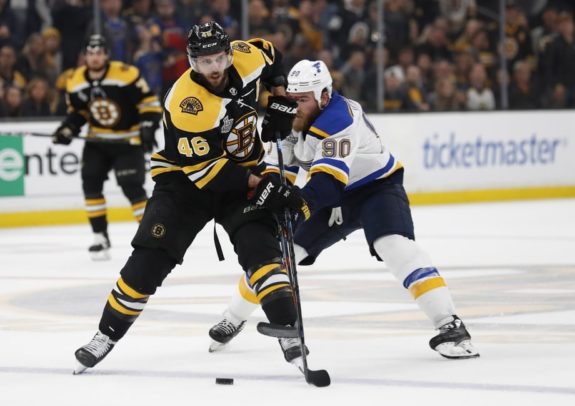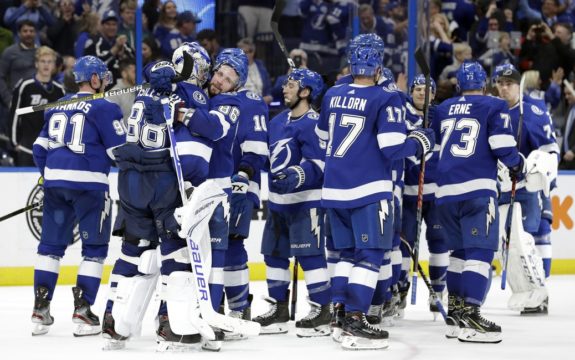The Tampa Bay Lightning ran away with the Atlantic Division (and the Eastern Conference and the Presidents’ Trophy) in 2018-19, but with the target squarely on their backs and 2020 on the horizon here are five factors that could keep the Boston Bruins in the hunt for first place.
Getting More Out of Tuukka Rask
Over the past four seasons, Tuukka Rask has had GSAA (goals saved above average) rates of 0.85 (20th among starters – those with at least 42 games – in 2015-16), 2.33 (15th in 2016-17), 7.79 (12th in 2017-18) and 3.21 (16th in 2018-19). His performance in the 2019 postseason was outstanding even by the lofty standards set in his first few seasons as a starter. Against the Toronto Maple Leafs, Columbus Blue Jackets, Carolina Hurricanes and St. Louis Blues he posted a gigantic 13.04 GSAA in just 24 games – a figure which (projected out for a full season) would have netted him a massive 27.2 GSAA in 50 games, a spot which would place him second overall in the league GSAA rankings.

Jaroslav Halak outplayed Rask in his 40 games during the regular season. The Bruins need that kind of effort from Halak and the postseason version of Rask. Recent regular-season Rask just won’t cut it if the team is to catch the Lightning.
Continued (Healthy) Contributions from Pastrnak, Bergeron & Marchand
For yet another season, Patrice Bergeron’s line was among the best in hockey with one player scoring 100 points (Mr. Brad Marchand) and two others riding rates that in healthy years would have paced them out for the century mark (David Pastrnak’s 81 points in 66 games and Bergeron’s 79 in 65).

If the age regression bug doesn’t bite Bergeron or Marchand, this trio possesses the ability to compete again as one of the top threesomes in the NHL and so long as they stay healthy, Bergeron and Pastrnak should climb the production ladder to help the Bruins unseat the Lightning and fend off the Maple Leafs for tops in the Atlantic Division.
Finding a Fit for Krejci’s Right Wing
In 2018-19, David Krejci set a new career high for assists (53) and matched the 20-goal mark for just the fourth time in his career all while going through a revolving door of linemates at right wing, though Jake Debrusk remained steady on his left.

For the new season, there are plenty of options to choose from, if no real definitive leaders of the pack when it comes to contenders for the spot. Prospects like Anders Bjork, Peter Cehlarik, Oskar Steen and Zach Senyshyn could jump up to fit the bill. There are also veterans Danton Heinen and Charlie Coyle who could move up from the third line to help with the load on Krejci. In any case, a major key is finding who works well with the Czech center early in the season – and sticking with him.
Continued Growth from Carlo and McAvoy
The 2019 Stanley Cup Playoffs were a bit of a coming out party for Charlie McAvoy and Brandon Carlo. Both shouldered major minutes and both proved to one extent or another that they were, in fact, the blue line stalwarts the franchise had been touting them to be.

Once they both get re-signed (one hopes sooner rather than later in the preseason process), the pair have different challenges awaiting them: For McAvoy the trial is staying healthy as he fully steps into the role as the Bruins’ number one defenseman, the first not named Zdeno Chara in well over a decade. For Carlo the test involves rounding out his offensive game to become at least a nominal point producer and doing it all in the defensive end with even more consistency than he showed in the latter half of 2018-19.
Hope for Less Thunder out of Lightning
The other factor – besides improving in 2019-20 – is hoping that the Lightning have a season less monstrously dominant than last. This remains eminently likely. Only once has a team managed the feat of back-to-back 125-point seasons (actually back-to-back-to-back for the Montreal Canadiens in 1975-76, 1976-77, and 1977-78) and only twice has a franchise mustered back-to-back 115-point seasons (the Canadiens’ four-year march that extended to 1978-79 and the Boston Bruins, whose two years atop the standings in 1970-71 and 1971-72, remains the pinnacle for a non-Habs team).

The Lightning led the league in shooting percentage at 12.2% and were third in save percentage (.916), so some regression to the mean might be in order. Also, their run of excellent player production has put them in a tough spot financially as they had to deal away valuable forward JT Miller to make room for Brayden Point’s inevitably hefty second contract.
No one is saying the Bolts are going to fall off the map, but a little deterioration here and there combined with needed progression on the Bruins’ behalf and the Atlantic Division might be theirs for the taking.
All stats courtesy of HockeyReference.com